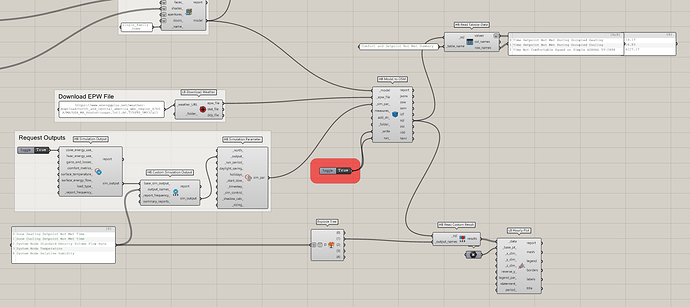Th bug fix has been fully merged and has made it through the automated release. So, if you run the Versioner now and restart Rhino, you should be able to open this sample file that shows you how to request and import all of the HVAC-related results that you could get with the Legacy components:
UnmetHours.gh (108.1 KB)
I hope you don’t mind that I now recommend doing this by requesting the outputs using the same workflow that you would use to request whatever other custom outputs you would want from the simulation. It’s just that, particularly for the Node-level outputs for the HVAC, it can be a tremendous amount of data and so I think it usually makes more sense to just request the one output that you are interested in rather than always requesting node flow rate, temperature, and humidity all at once.
And, yes, that’s exactly how the “Read Tabular Data” component works. Just look up a table you want in the HTML file and then you can import that data to Grasshopper.
For heating and cooling details, it would be tough to implement some of them in a way that is relevant to the many templates that can be assigned with a given HVAC component. This is actually the main reason why we have 3 different components to assign the HVAC templates right now (eg. certain customization inputs like heat recovery are just not relevant to some types of HVAC that don’t have ventilation). Most of the really meaningful inputs like heatRejectionType_ on cooling details are essentially supported now by the fact that there are so many variations on the plant side of things with the many new HVAC templates. And the centralPlant_ is built into the way that the HVAC templates are assigned, which is almost always the preferred option.
I should ask what input parameters on these heating/cooling components do you miss? If it’s just one or two like the heating/cooling COP, maybe we can find a way to support it for most of the HVAC templates, though I don’t know what the COP would mean for a system like evaporative coolers, for example. It’s also that these new HVAC templates are purposefully set up so that it’s hard to mess up the assumptions and make a wrong design decision based on them. This is great for people who only know what their HVAC is called but don’t know the details of the individual pieces of HVAC equipment. But it’s not really intended for major customization and this is intentional.
At a certain point, our answer is just “use ironbug if you need full customization” since that’s really the tool that is set up in a manner that you need to understand the equipment of the HVAC template in order to make changes to it. I should also mention that you can use IronBug now with the LBT plugin using the workflow that Mingbo posted here. I know the end of the release notes say that “Ironbug Integration” is a currently unsupported feature but this just means that you can’t assign an Ironbug HVAC to a honeybee Model or write it into a JSON file or use Ironbug on Mac. You can still apply an Ironbug HVAC to an OSM as long as you’re in Grasshopper on Windows.
